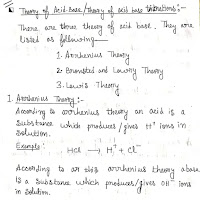Acid-Base & Non-Aqueous Titrations (Unit-2) - Pharmaceutical Analysis Handwritten Notes
Download these handwritten notes focusing on Acid-Base and Non-Aqueous Titrations, specifically within the context of Unit-2 of Pharmaceutical Analysis. These notes offer a simplified overview of the principles, theories, and applications of these titrimetric methods.
Keywords: Acid-Base Titration, Non-Aqueous Titration, Unit-2, Pharmaceutical Analysis, Handwritten Notes, Acid-Base Indicators, Neutralization Curves, Solvents, Acidimetry, Alkalimetry, Sodium Benzoate, Ephedrine HCl, PDF Download, Study Material.
Ace Your Titrations: Unit-2 Handwritten Notes on Acid-Base & Non-Aqueous Techniques
Titration techniques are fundamental to quantitative analysis in pharmacy. These Unit-2 handwritten notes provide a clear and concise guide to understanding Acid-Base and Non-Aqueous Titrations.
Key Topics Covered in These Notes:
- Acid base titration: Theories of acid base indicators, classification of acid base titrations and theory involved in titrations of strong, weak, and very weak acids and bases, neutralization curves
- Non aqueous titration: Solvents, acidimetry and alkalimetry titration and estimation of Sodium benzoate and Ephedrine HCl
Delving Deeper into Titration Concepts (Likely Content):
- Acid-Base Titrations: Understanding the Fundamentals
- Acid-Base Indicators: The notes probably explain the mechanism of acid-base indicators, how they change color based on pH, and factors influencing their selection.
- Classification: Expect details on the different types of acid-base titrations (strong acid-strong base, weak acid-strong base, etc.) and the principles behind each.
- Titration Theory: The notes will likely delve into the equilibrium reactions involved in titrations, including calculations of pH at various points in the titration.
- Neutralization Curves: Understanding the shape of neutralization curves, the location of the equivalence point, and how these curves are used to select appropriate indicators.
- Non-Aqueous Titrations: Expanding the Possibilities
- Solvents: The notes probably discuss the different types of solvents used in non-aqueous titrations (protic, aprotic, amphiprotic) and their properties, as well as how the choice of solvent affects the titration.
- Acidimetry and Alkalimetry: The principles of titrating bases (acidimetry) and acids (alkalimetry) in non-aqueous solvents.
- Estimations: The application of non-aqueous titrations for the determination of Sodium Benzoate and Ephedrine HCl, including the relevant reaction equations and calculations.
Benefits of Studying with These Handwritten Notes:
- Simplified Explanations: Handwritten format can make complex topics easier to digest.
- Focused Review: Ideal for quick review of key concepts.
- Complement to Textbooks: Use alongside your textbook for a well-rounded understanding.
Download these Unit-2 Handwritten Notes and get ready to master Acid-Base and Non-Aqueous Titrations!
Info!
If you are the copyright owner of this document and want to report it, please visit the copyright infringement notice page to submit a report.

